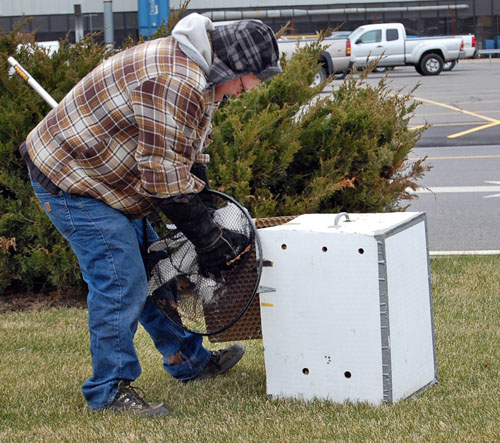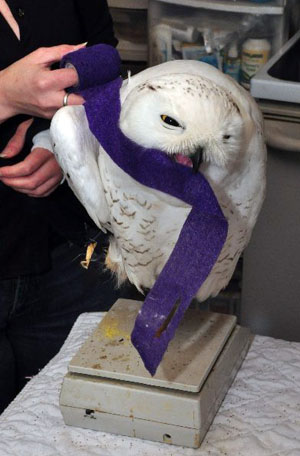
Holiday visitor
The Schenectady campus had an unexpected visitor fly in over the holidays, but he didn’t need a sleigh or reindeer, and he wasn’t looking for free cookies.
On December 27 campus security was called to building 263 where a snowy owl had taken shelter in the bushes next to the building. After determining the bird was injured, they called North Country Wild Care, a local non-profit group of wildlife rehabilitators, and a representative picked up the bird to care for it until it can be released back into the wild.

Wildlife rehabilitator Eric Brown carefully picks up the injured owl on the Schenectady GE campus.
Snowy owls are not often seen in this area, according to rehabilitator Eric Brown, who works with several different wildlife care groups. Given the bird’s normal habitat near the Arctic circle, he said it’s effectively spending its “summer” here in Schenectady and would normally head back north by the end of February.
After picking up the bird, he found reports on the web site of a local birdwatchers club that has been tracking this owl over the past month as it roamed the Schenectady and Rotterdam areas.
The snowy owl presents an impressive sight in the wild, with its large wingspan and striking white plumage that makes it stand out when there’s no snow cover. Brown said this particular bird, weighing in at just under three pounds, is a young male not yet fully grown. Snowy owls are one of the largest owl species and can grow up to 6.5 lbs with a wingspan of almost five feet.

“Mr. ‘Nowy” may look cute, but he did not like captivity and used his sharp beak to prove it.
A visit to a Ballston Spa veterinarian revealed the owl had a dislocated wing joint—the equivalent of an elbow in a human, and some head trauma. The vet re-inserted the bone, then wrapped the wing to allow it to heal.“He hit something,” said Brown, judging the bird had run into a building or other obstacle.
Brown said the bird was also suffering from a variety of both external and internal parasites and various medicines were prescribed to cure those. The internal ones likely came from the bird’s local winter diet that includes pigeons that often carry para- sites. In the summer the snowy owl feasts on lemmings, moles, and jackrabbits on the tundra.
The bird will stay at Brown’s home for at least a couple of weeks until the parasites have been eliminated and the wing can heal and get therapy to stretch and exercise the unused muscles.
“It’s all going to be a matter of how his elbow looks,” said Brown.“We try to get them back into the wild as quick as we can. He’s going to have to migrate home.”
Postscript:The owl,named“Mr.‘Nowy”by his rescuers, did well in captivity, and was released in mid- March near Fort Edward. (Note: Handout Photos)